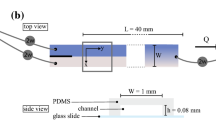Abstract
A universal theory describing the deformation and atomization processes of liquid droplets and columns is proposed on the basis of the first principle of fluid dynamics. Based on the proposed theory, previously reported empirical models such as the TAB model and the OPT model can be derived along with their arbitrary constants. Moreover, this theory provides a formulation for breakup phenomena when two droplets collide. It is also shown on the basis of this theory that the atomization processes of liquid droplets are mathematically similar to biological cell proliferation. This is because actual living cells mainly consist of liquid and because both systems are dominated by three essential forces, that is, internal convection, surface tension, and the internal pressure gradient due to energy input. Finally, it will be shown that the present theory offers a qualitative explanation of the unlacing processes of biological molecules such as the base pairs of purines and pyrimidines surrounded with water molecules, that is, the chemical reaction processes related to the hydrogen bonds.
Similar content being viewed by others
References
G. Brant Foote, The water drop rebound problem: Dynamics of collision. J. Atmos. Sci.,32 (1975).
P.R. Brazier-Smith, The stability of a water drop oscillating with finite amplitude in an electric field. J. Fluid Mech.,50, Part 3 (1971).
K.E. Gustafson and J.A. Sethian, Vortex Methods and Vortex Motions. SIAM, Philadelphia, 1991.
H. Hiroyasu and T. Kadota, Fuel droplet size distribution in diesel combustion chamber. SAE Paper 740715, 1974.
K. Homma and J. Woodland Hastings, Cell growth kinetics. J. Cell Sci.,92 (1989).
K. Houtani, Creation of cells. Biohistory,3, No. 2 (1995).
D.E. Ingber, The Architecture of Life. Scientific American, 1998.
E.N. Lorentz, Deterministic non-periodic flows. J. Atmos. Sci.,20 (1963), 130–141.
K. Naitoh and K. Kuwahara, Large eddy simulation and direct simulation of compressible turbulence and combusting flows in engines based on the BI-SCALES method. J. Fluid Dynamics Research,10 (1992).
K. Naitoh, H. Kokita, Y. Takagi and K. Kuwahara, Numerical predeiction of fuel secondary atomization behavior in SI engine based on the oval-parabola trajectories model. SAE Paper 940526, 1994.
K. Naitoh, Four-group equation of genetic algorithm. JSME International Journal, Series C,38, No.2 (1995).
K. Naitoh and Y. Takagi, Synthesized spheroid particle method for calculating spray phenomena in direct-injection SI engines. SAE Paper 962017, 1996.
K. Naitoh, Fuel Injector. United States Patent, July 30, 1996.
K. Naitoh, Applications of cyto-fluid dynamic theory to engineering problems. Proceedings of Japan Society of Industrial and Applied Mathematics, 1998.
K. Naitoh, Cyto-fluid dynamic theory of fuel atomization processes. Proceedings of COMODIA 98, 1998.
K. Naitoh, Cyto-fluid dynamic theory of atomization processes. Proceedings of IFP International Conference, France, 1998.
K. Naitoh, Synthesized spheroid particle (SSP) method for calculating the spray atomization processes. Jet Flow Engineering,15, No. 1 (1998), 18–23.
K. Naitoh, Macroscopic kinetic equation for a genetic algorithm. Japan J. Indust. Appl. Math.,15, No.1 (1998), 87–133.
K. Naitoh, Introns for accelerating quasi-macroevolution. JSME International Journal, Series C,41, No.3 (1998).
K Naitoh, Optimization of liquid sprays based on the cytofluid dynamic theory. Proceedings of Japan Society of Mechanical Engineering, 1999.
K. Naitoh, Cyto-fluid dynamic theory of atomization processes. Oil & Gas Science and Technology,54, No.2 (1999).
K. Naitoh, Introns and instinct. Bioscience and Industry, 1999.
P.J. O’Rourke and A.A. Amsden, The TAB method for numerical calculation of spray droplet breakup. SAE Paper 872089, 1987.
R.D. Reitz and F.V. Bracco, Mechanisms of atomization of a liquid jet. Phys. Fluids,25 (10) (1982).
J. Senda, et al., Modeling of diesel spray impingement on a flat wall. SAE Paper 941894, 1994.
A. Umemura, An experimental investigation on the collision behavior of hydrocarbon droplets. Proceedings of Tsukuba International Workshop on Mechanics of Reacting Flows, 1990.
M. Van Dyke, An Album of Fluid Motion. The Parabolic Press, California, 1988.
J.D. Watson, et al., Molecular Biology of the Gene (Fourth edition). The Benjamin/ Cummings Publishing Company, U.S.A, 1987.
H. Yanagawa, How Life Originated. TBS Britannica, 1991.
Tokyo Tenmondai (ed.), Rika Nenpyou. Marzen, 1983.
Author information
Authors and Affiliations
Corresponding author
About this article
Cite this article
Naitoh, K. Cyto-fluid dynamic theory. Japan J. Indust. Appl. Math. 18, 75–105 (2001). https://doi.org/10.1007/BF03167356
Received:
Revised:
Issue Date:
DOI: https://doi.org/10.1007/BF03167356




